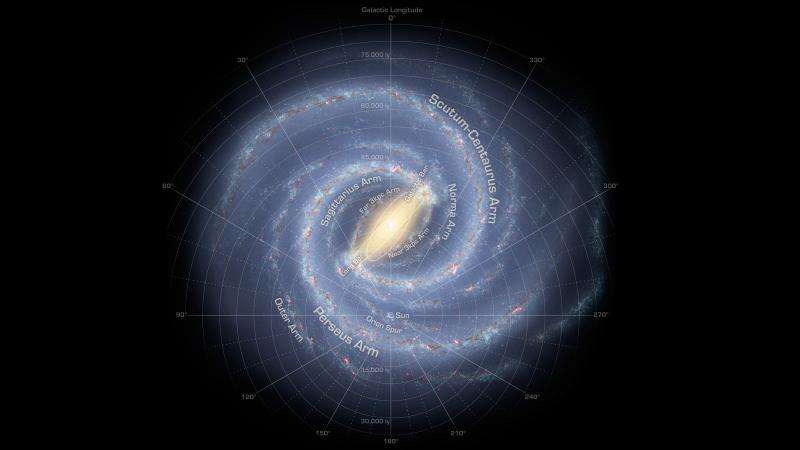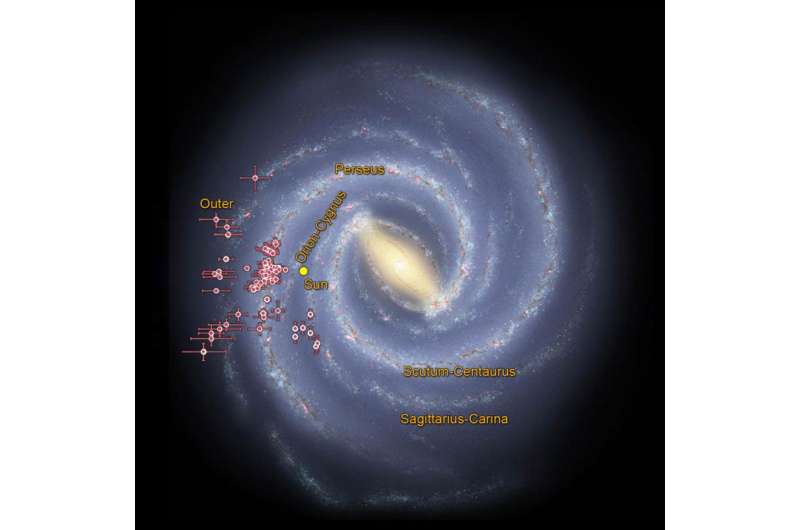Astronomers using data from NASA's Wide-field Infrared Survey Explorer, or WISE, are helping to trace the shape of our Milky Way galaxy's spiral arms. Credit: NASA/JPL-Caltech/Federal University of Rio Grande do Sul
Imagine trying to create a map of your house while confined to only the living room. You might peek through the doors into other rooms or look for light spilling in through the windows. But, in the end, the walls and lack of visibility would largely prevent you from seeing the big picture.
The job of mapping our own Milky Way galaxy from planet Earth, situated about two-thirds of the way out from the galaxy's center, is similarly difficult. Clouds of dust permeate the Milky Way, blocking our view of the galaxy's stars. Today, researchers have a suitable map of our galaxy's spiral structure, but, like early explorers charting new territory, they continue to patiently and meticulously fill in the blanks.
Recently, researchers have turned to a new mapping method that takes advantage of data from NASA's Wide-field Infrared Survey Explorer, or WISE. Using WISE, the research team has discovered more than 400 dust-shrouded nurseries of stars, which trace the shape of our galaxy's spiral arms. Seven of these "embedded star clusters" are described in a new study published online May 20 in the Monthly Notices of the Royal Astronomical Society.
"The sun's location within the dust-obscured galactic disk is a complicating factor to observe the galactic structure," said Denilso Camargo, lead author of the paper from the Federal University of Rio Grande do Sul in Brazil.
The results support the four-arm model of our galaxy's spiral structure. For the last few years, various methods of charting the Milky Way have largely led to a picture of four spiral arms. The arms are where most stars in the galaxy are born. They are stuffed with gas and dust, the ingredients of stars. Two of the arms, called Perseus and Scutum-Centaurus, seem to be more prominent and jam-packed with stars, while the Sagittarius and Outer arms have as much gas as the other two arms but not as many stars.
Astronomers using data from NASA's Wide-field Infrared Survey Explorer, or WISE, are helping to trace the shape of our Milky Way galaxy's spiral arms. This illustration shows where WISE data revealed clusters of young stars shrouded in dust, called embedded clusters, which are known to reside in spiral arms. The bars represent uncertainties in the data. The nearly 100 clusters shown here were found in the arms called Perseus, Sagittarius-Carina, and Outer -- three of the galaxy's four proposed primary arms. Our sun resides in a spur to an arm, or a minor arm, called Orion Cygnus. Credit: NASA/JPL-Caltech/Federal University of Rio Grande do Sul
The new WISE study finds embedded star clusters in the Perseus, Sagittarius, and Outer arms. Data from the Two Micron All Sky Survey (2MASS), a ground-based predecessor of WISE from NASA, the National Science Foundation and the University of Massachusetts, Amherst, helped narrow down the distances to the clusters and pinpoint their location.
Embedded star clusters are a powerful tool for visualizing the whereabouts of spiral arms because the clusters are young, and their stars haven't yet drifted away and out of the arms. Stars begin their lives in the dense, gas-rich neighborhoods of spiral arms, but they migrate away over time. These embedded star clusters complement other techniques for mapping our galaxy, such as those used by radio telescopes, which detect the dense gas clouds in spiral arms.
"Spiral arms are like traffic jams in that the gas and stars crowd together and move more slowly in the arms. As material passes through the dense spiral arms, it is compressed and this triggers more star formation," said Camargo.
More information: "Tracing the Galactic spiral structure with embedded clusters." MNRAS (July 11, 2015) Vol. 450 4150-4160 DOI: 10.1093/mnras/stv840
Journal information: Monthly Notices of the Royal Astronomical Society
Provided by Jet Propulsion Laboratory

























